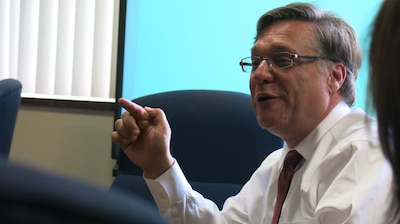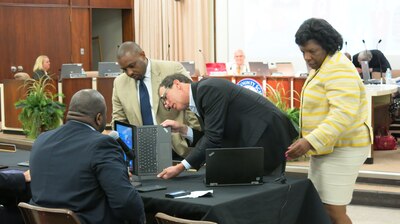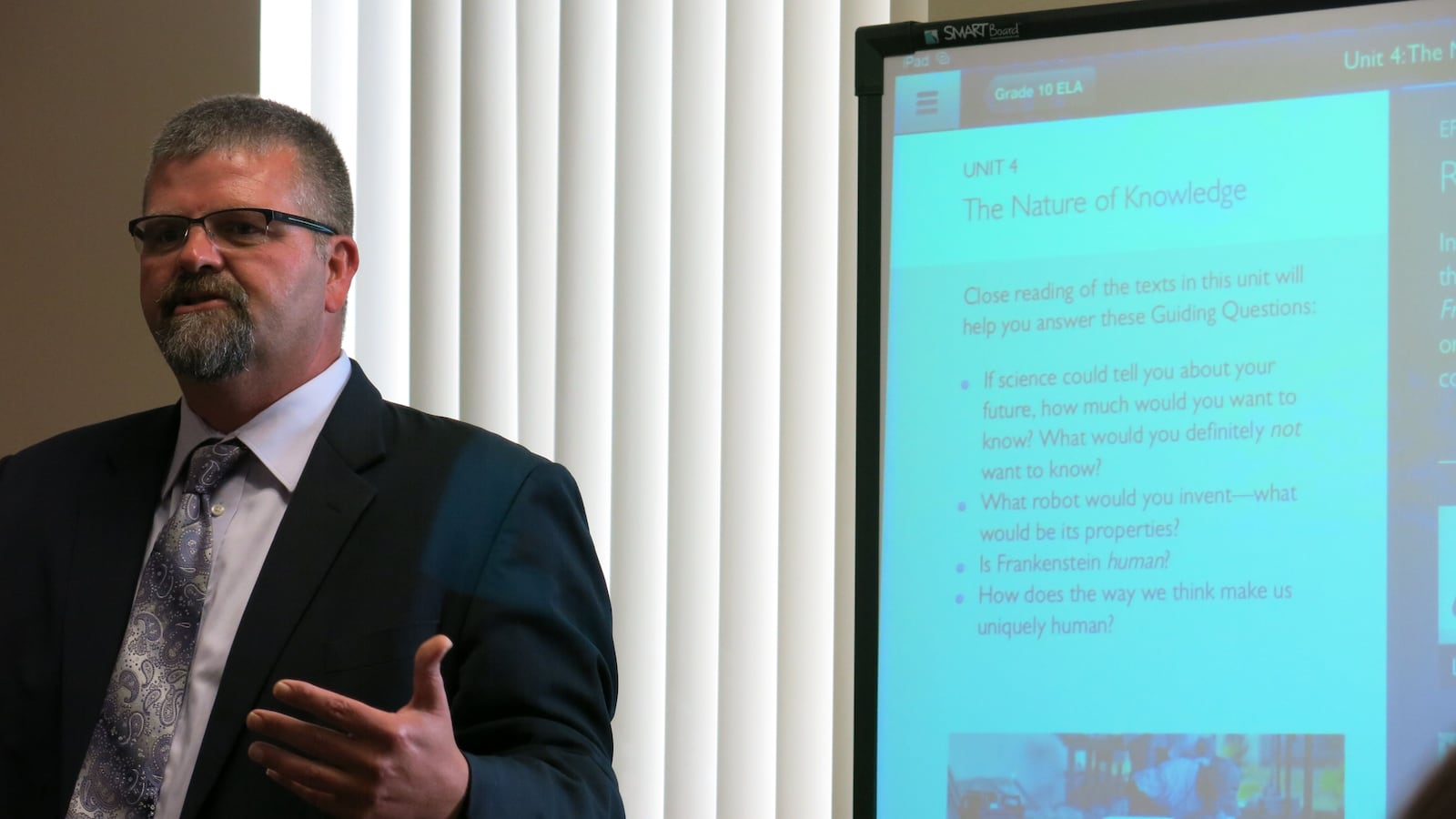At the Shelby County district building on Wednesday, school board members were digging deep into 10th grade English language arts—and the questions at the core of Mary Shelley’s Frankenstein—as they were stepped through a model lesson of a new blended learning program, in which much of students’ work and learning takes place on a tablet computer.
Brad Osborn, the vice president of business development for education publishing company Pearson, pulled up a reading lesson and showed the sorts of screens and questions students would encounter after reading Frankenstein.
“We keep hearing how robots are getting smarter and they’re going to rule the world,” said Osborn. “So we want to ask our kids, what does it mean to be human?”
“Well, what do you think?” Osborne said to Shelby County Schools board chair Kevin Woods. “What does it mean?”
Shelby County Schools is looking to blended learning to help schools reach an ambitious set of goals that includes having 80 percent of students graduating from high school college- and career-ready by 2025. Next year, a new blended learning program will be piloted in 16 schools, including some of the district’s neediest and most promising: Those receiving students from schools that are closing, and schools in the district’s turnaround-focused “Innovation Zone.” District officials say the program represents a major shift in how teachers will teach and how students will learn.
On Tuesday, the Memphis board of education voted to approve a $5.5 million, three-year contract to purchase the devices. Each student and teacher in the participating schools will receive a device that they can take home.
On Wednesday, board members got a preview of what the curriculum in those 16 schools will look like. Representatives of Pearson Publishing, which has a one-year contract with the district to provide curriculum and support, presented slides and answered questions about how the program will work in Memphis.
Cleon Franklin, the head of virtual education for Shelby County Schools, said that while people often focus on the devices in conversations about digital learning, the real change is in the curriculum and how students will be learning.
Unlike previous versions of digital textbooks or school-based curricula, the Pearson program means students will receive most of their English and math instruction from videos and guided questions on the digital tablet itself. Teachers shift from being the “sage on the stage,” solely responsible for explaining content laid out in a textbook, to facilitators of what Pearson described as a workshop model for learning.

Competitive Application
Thirty-nine schools applied for the program, which might eventually be used in classrooms around the city, said Franklin. Interested principals had to guarantee, among other things, that all staff were on board with the program and would participate in professional development. Schools pledged to be open to sporadic visits from the virtual education department, to host parent trainings, and to create common spaces where students can use devices.
Seven of the pilot schools are receiving students from schools that will be shuttered next year as part of an effort to consolidate resources and improve academics. During a series of heated meetings protesting the closings, superintendent Dorsey Hopson II said the blended learning pilot was an example of the district improving academic offerings for students affected by the closings.
Schools and teachers are touting their participation: An image of a laptop and announcement about the program is featured on the homepage of Lowrance Elementary School, one participating school. Karsaunder Carson, a teacher at Caldwell-Guthrie, another participating school, said, “We are excited about that.”
Shelby County’s Franklin said that the district intentionally chose a mix of schools that had “high capacity” to implement the program—their teachers are already using technology, for instance—and those that had less experience. Since the district eventually hopes to have blended learning in more of its schools, “we wanted to learn the tough lessons now,” he said.
Preparing for change
The program board members saw Wednesday includes lessons aligned to the Common Core State Standards. Schools will use the program mainly for math and English language arts, though readings include history and science features, Franklin said.

In a sample elementary school math lesson, students would watch a video laying out a problem involving students opening and shutting doors in a specific pattern. Students were asked what strategy they would use to determine how many doors were open before actually answering. Students had constant access to a glossary feature, but could also use non-digital tools like “counters” as part of their strategy.
Lessons like that one might be done at home, with students then coming to school with questions about the content—an approach known as the “flipped classroom.”
At school, students might rotate between a computer station, a group-work station, and a teacher-led station.
The curriculum is differentiated: For instance, in a lesson on Huckleberry Finn, advanced readers might probe into symbolism on their devices while struggling readers focused on comprehension.
In upper grades, district officials said, students might move through courses at their own pace. In lower grades, students can choose between different lessons or readings focusing on the same skills.
All the while, teachers have access to students’ screens and information. Teachers can notice where each student is struggling, or even turn students’ devices off if they are off-track.
“It’s a new instructional model: Instead of the teacher in front and kids absorbing, the teacher manages a set of activities,” Singer said.
Franklin said that Shelby County Schools had examined a blended learning program in Huntsville, Ala., and had had concerns that, in some instances, when students got things wrong, the digital curriculum did not provide sufficient feedback for students to get the correct answer without the teacher being present.
He said the new program addresses that concern. Assessments are embedded throughout the program. But while teachers will have immediate access to how students did, students receive coaching from the program to help explain what they missed.
Pearson also helped design questions for the PARCC exam, which Tennessee students are likely to take in 2015-16. Singer said that means students using the blended learning program will be prepared for assessments they’ll face down the line. “People say that good test takers have an advantage. In Memphis, they won’t,” Singer said.
Potential issues
Franklin said that the devices, and Pearson’s virtual learning program, were unanimously selected by a working group of teachers and principals.
In the Wednesday meeting with Pearson, board members Chris Caldwell and Kevin Woods asked what issues might come up as the program is implemented.
Singer said the district should be prepared to address schools struggling with technological issues; for teachers who are less-than-enthused about the new program; and for parents who are uncertain about the new technology. “It’s a change management issue,” he said, pointing out that any new initiative is often met with resistance.
Franklin said that the district had already ensured pilot schools would have enough bandwidth. District officials said teachers would be taught by other teachers, so they could “speak the same language.”
As for theft and hacking issues that have plagued other one-to-one device programs, Franklin and Singer both downplayed concerns. “The devices have a market value of zero,” as they are only operable by students, Franklin told the board.
Still, Franklin said that the district had decided not to give students backpacks or carrying cases for the devices so they would not be easily identified as having devices.
Board members were enthusiastic, especially about the idea of students guiding each other through group work. Caldwell said that the initiative might preview a move away from textbooks for the district as a whole.
“With this, everyone’s a learner and everyone’s a teacher,” Caldwell said. “It’s an environment that trains you for jobs you’re doing.”
As for what makes a human, board chair Woods cracked a joke before saying that at least part of it is humor.
At least in this presentation, the devices cracked no jokes.
The following schools will pilot the blended learning program:
Caldwell-Guthrie Elementary
Cherokee Elementary
Douglas K-8
Fairley Elementary
Ford Road Elementary
Hamilton Middle
Highland Oaks Middle
Levi Elementary
Lowrance K-8
Lucy Elementary
Maxine Smith STEAM Academy
Melrose High
Raineshaven Elementary
Riverview K-8
Riverwood Elementary
Sherwood Middle
Contact Jackie Zubrzycki at jzubrzycki@chalkbeat.org.
Follow us on Twitter: @jzubrzycki, @chalkbeattn.
Like us on Facebook: https://www.facebook.com/chalkbeattn.
Sign up for our newsletter for regular updates on Tennessee education news: http://tn.chalkbeat.org/newsletter/


